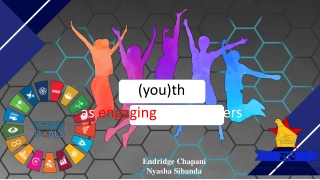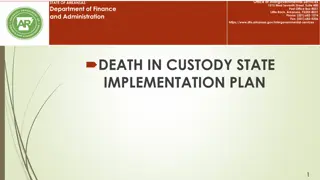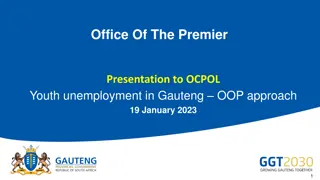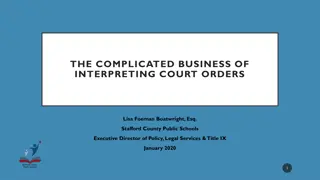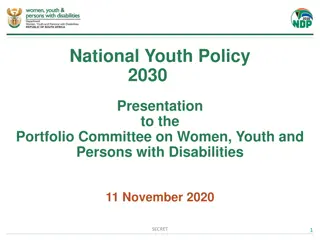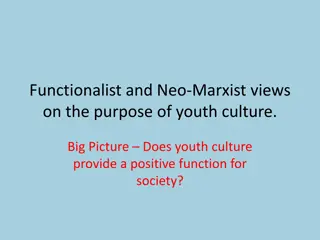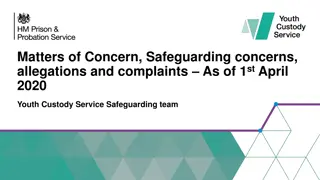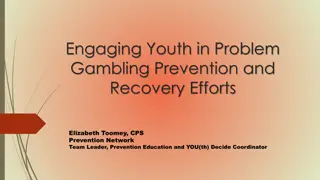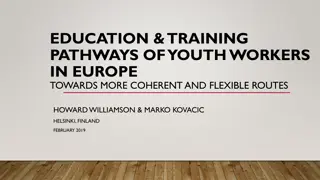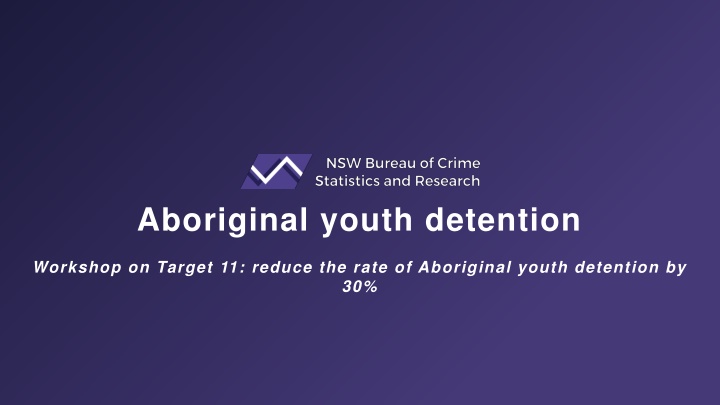
Reducing Aboriginal Youth Detention Rates: NSW Trends & Data Analysis
Explore the trends and data analysis surrounding Aboriginal youth detention rates in New South Wales (NSW), focusing on the goal to reduce the rate by 30%. The analysis covers changes in custody rates, population breakdown, demographics by age and gender, and the duration of stay in custody.
Download Presentation

Please find below an Image/Link to download the presentation.
The content on the website is provided AS IS for your information and personal use only. It may not be sold, licensed, or shared on other websites without obtaining consent from the author. If you encounter any issues during the download, it is possible that the publisher has removed the file from their server.
You are allowed to download the files provided on this website for personal or commercial use, subject to the condition that they are used lawfully. All files are the property of their respective owners.
The content on the website is provided AS IS for your information and personal use only. It may not be sold, licensed, or shared on other websites without obtaining consent from the author.
E N D
Presentation Transcript
Aboriginal youth detention Workshop on Target 11: reduce the rate of Aboriginal youth detention by 30%
Trends in the rate of Aboriginal youth custody in NSW Rate of 10-17 year olds in custody on an average day 40 36.1 35 33.4 Age standardised Imprisonment rate (per 10,000) 32.2 28.9 30 28.5 28.3 From 2010/11 to 2018/19 25.7 25.3 25 22.4 Aboriginal youth custody rate decreased by 38% 18.8 20 15 Non-Aboriginal rate decreased by 36% 10 In 2019/20 Aboriginal 10-17 year olds were 13 times more likely to be in youth custody 5 2.2 1.9 1.8 1.7 1.6 1.4 1.4 1.4 1.4 1.4 0 2010-11 2011-12 2012-13 2013-14 2014-15 2015-16 2016-17 2017-18 2018-19 2019-20 2 Aboriginal Non-Aboriginal
Target 11 in the NSW context Aboriginal youth in custody - rate per 10,000 40.0 34.0 33.4 33.9 35.0 30.4 29.2 30.0 26.8 26.8 Rate per 10,000 2019 NSW incarceration rate 25.0 22.8 20.0 Closing the Gap target 18.8 Actual rate (12 monthly average) 15.0 16.3 10.0 5.0 0.0 2014 2015 2016 2017 2018 2019 2020 2021 2022 2023 2024 2025 2026 2027 2028 2029 2030 2031 Aboriginal youth in custody 180 156 153 149 160 142 141 139 129 140 2019 NSW incarceration rate 120 Number 111 100 Closing the Gap target 99 80 Actual number (12 monthly average) 80 60 40 20 0 3 2014 2015 2016 2017 2018 2019 2020 2021 2022 2023 2024 2025 2026 2027 2028 2029 2030 2031
Aboriginal youth custody population Sentenced 45% Sentenced 45% 250 Dec 2015 Dec 2019 Remand 55% Remand 55% 200 Change from Dec 2015 to Dec 2019: 150 Daily average 150 118 Total population Down 21% 32 people 100 83 65 Remand Down 22% 18 people 67 50 54 Sentenced Down 20% 13 people First COVID-19 restrictions 0 Jun-15 Dec-15 Jun-16 Dec-16 Jun-17 Dec-17 Jun-18 Dec-18 Jun-19 Dec-19 Jun-20 Dec-20 Jun-21 4
Aboriginal youth custody by age & gender Aboriginal youth in custody: 12 monthly rolling average 45 COVID-19 Period 40 37 Males 17 years (up 3%) 35 30 Males 16 years (down 38%) 30 25 Males 15 years (down 49%) 21 20 10% of Aboriginal young people in custody are female 19 17 Females (down 4%) 14 15 13 10 10 Males 14 years (down 44%) 7 7 5 3 Males 10-13 years (down 58%) 0 5 % Change from December 2015 to December 2019
How long do Aboriginal young people spend in custody? Custody RECEPTIONS by length of stay Large increase in short term remand In 2019 over half in custody for under 48hrs 2015 to 2019: custody episodes under 48 hours increased 33% (up 204 episodes). Contrasts with a drop in custodial episodes over 48 hours. The largest drop was in 2-3 month episodes (down 36%) and 3-6 month episodes (down 37%). 1000 900 2015 2019 814 800 n=1492 n=1517 700 610 600 500 400 300 228 186 200 155 139 138 130 105 92 91 Short term remand affects individuals but has little affect on custody volume 82 70 68 100 56 45 0 Less than 48 hrs 2 days - 1 week 1 - 2 weeks 2 week- 1 month 1 - 2 months 2 - 3 months 3 - 6 months Over 6 months Custody POPULATION by length of stay Drop in custody due to fewer young people in custody for a long time 2015 2019 70 65 n=159 n=123 60 55 The increase in short term remand has little impact on the custody population, due to the brevity of those episodes. The reduction in the custodial pop is from fewer young people spending : 3-6 months on remand (down 15) or more than 6 months (down 10) 50 46 40 31 30 20 17 15 13 9 9 8 10 3 3 2 2 2 2 6 0 Less than 48 hrs 2 days - 1 week 1 - 2 weeks 2 week- 1 month 1 - 2 months 2 - 3 months 3 - 6 months Over 6 months
Summary: key trends Reoffending Sentencing Bail & Remand Custody population decreasing Legal actions The number of Court bail refusals rose by 40% Violent offences made up 75% of the increase in sentenced custody & 66% of the increase in remand (in 5 years) Total pop down 21% Some evidence of systemic bias Proven appearances rose 10%in 5 years, leading to more prison sentences Total population up 61% in 10 years 32 fewer Aboriginal young people in 2019 v 2015 Multiple and frequent contacts with the system from a young age compounded by socio economic factors Bail refusal rates also rose by 22% for Police and 11% for courts Remand is growing faster than sentenced custody: up 143%in 10 years AND sentenced custody Violent offending made up 27%of the increase in court volume and had relatively high imprisonment rates Decline from remand Justice procedure offences made up 27% of the growth in sentenced custody The volume of bail breaches established in court rose but the revocation rate fell Decrease in long custody episodes Almost half of Aboriginal offenders reoffend within 6 months of release Increase in short term remand episodes 7
Police proceedings against Aboriginal young people Aboriginal young people proceeded to court Change from 2015 to 2019 5,000 75% 68% 68% 70% 4,000 65% Proportion to court Stable at 68% 3,000 60% 55% 2,000 3,696 3,651 3,545 3,406 3,332 3,327 Total volume to court Court proceedings declined by 10% (down 369) 3,102 50% 1,000 45% 0 40% 2015 2016 2017 2018 2019 % to Court 2020 2021 Proceeded against to court Court diversion for Aboriginal young people Proportion diverted Stable at 32% 32% 2,500 35% 32% 30% 2,000 25% Warnings* Up 3% (Up 12) 366 1,500 409 382 455 20% 378 410 342 15% 1,000 1,142 1,021 10% 1,065 1,018 1,079 917 Cautions Down 11% (down 124) 1,005 500 5% 260 212 200 193 2019 186 2018 133 2017 117 2016 0 0% 2015 2020 2021 YJCs Down by 9% (down 19) 8 Youth Justice Conference Cautions Warnings* % Diversion * Excludes warnings issued for fare evasion
Court legal action by offence type Police proceedings against Aboriginal young people to Court: 2015 vs 2019 by offence* Large drop in legal action for property offences Between 2015 to 2019 court legal action trends showed: 847 Theft -148 (17%) 699 685 Break and Enter -185 (27%) 500 361 Property offences charges fell: Break and enter fell 27% Theft fell 17% Trespass, criminal intent, riot /affray 351 331 Non DV-assault 323 189 90 (48%) Intimidation / stalking 279 Violent offence charges were mixed: Intimidation/stalking increased 48% DV assault fell 19% Non-DV assault stable 342 -101 (30%) Property Damage 241 169 Robbery 180 136 28 (21%) Breach AVO 164 167 -31 (19%) DV-Assault 136 67 Fraud 84 87 Drugs 81 55 Sexual Assault 61 43 Weapons 55 57 Resist arrest / failure to appear 51 2015 2019 87 Traffic -37 (43%) 50 0 200 400 600 800 1000 <#> *Offences with more than 50 court legal actions in a year
Summary: key trends Reoffending Sentencing Bail & Remand Custody population decreasing Legal actions Court actions down 10% 369 fewer Aboriginal yp in 2019 v 2015 Total pop down 21% Total population up 61% in 10 years 32 fewer Aboriginal young people in 2019 v 2015 Remand is growing faster than sentenced custody: up 143%in 10 years AND sentenced custody Decline in property offence charges Decline from remand Consistent split between diversion/ court Decrease in long custody episodes Increased court actions for intimidation/stalking & breach AVO Increase in short term remand episodes 10
Bail refusal volumes and rates Bail refusal rate 60% COVID 50% 43.9% 41.7% 41.2% 38.5% 37.1% 40% 34.3% 33.5% 30% Police bail refusal 20% 10% 0% 2015 2016 2017 2018 2019 2020 2021 11
Bail refusal volumes and rates Bail refusal rate Bail decisions Change between 2015-2019 60% Held in police / court cell or short term remand COVID 50% 43.9% Police bail refused, court bail granted 41.7% 41.2% Up 39% (183) 38.5% 37.1% 40% 34.3% 33.5% 650 732 464 503 555 612 647 30% Police bail refusal 20% Down 8% (50) Court bail refused 18.8% 18.8% 18.8% 18.8% 18.2% 458 521 594 502 567 584 544 17.2% 17.1% 10% Court bail refusal COVID 0% 2015 2016 2017 2018 2019 2020 2021 Police bail granted / dispensed with 2102 1927 1913 1899 1700 Bail decision agreement 1602 1548 Down 19% (402) 60% 55% 56.1% 2015 2016 2017 2018 2019 2020 2021 50% 50.5% 50.0% Volume and proportion of police bail refusals increase From 2015 to 2019, police bail refusals increased by 13%, and court bail following police bail refusal increased by 39% The police bail refusal rate increased 23%while the court bail refusal rate remained stable. This means for every 100 court legal actions, 8 additional young persons are held on in police / court cell or short term remand 48.8% 45% 45.7% 40% 41.6% 41.3% 35% COVID 12 30% 2015 2016 2017 2018 2019 2020 2021
Bail breach and revocation Bail breach established and revocation Increase in court established breaches; decreased revocation rate 2,500 40% 35% 39% COVID 31% Total breaches of bail increased by 24% 2,000 32% Bail breaches Down 38% 24% 24% 25% 1,500 24% 22% 20% Revocations decreased by 24%. This was driven by a 32% decrease in revocations for technical breaches Bail breaches up 24% 1174 1162 1,000 16% 1050 1040 943 915 868 500 8% Curfew breaches are the most common. These have a 26% revocation rate 368 328 Bail revocations Down 24% 300 287 280 197 206 0 0% 2015 2016 2017 2018 2019 2020 2021 Breach of bail established Revocations Revocation rate (%) Most common types of bail breaches (2019) Bail revocations by breach type 450 40% 400 368 35% Curfew 336 77 19% COVID 328 350 300 30% 287 280 300 Further offence 166 101 38% 25% 250 263 206 Residence 95 30 24% 197 234 200 205 186 20% 179 150 No-contact 58 9 13% 143 15% Bail continued 142 100 Reporting 37 15 29% 10% Bail revoked 105 50 101 101 95 94 63 55 5% % revoked 0 Place restriction 43 4 9% 13 2015 2016 Further offence 2017 2018 2019 Technical breach 2020 2021 0 0% 0 50 100 150 200 250 300 350 400 450
Summary: key trends Reoffending Sentencing Bail & Remand Custody population decreasing Legal actions Court actions down 10% 369 fewer Aboriginal yp in 2019 v 2015 Police bail refusal rate rose 23% Court bail refusal rate remained stable Total pop down 21% 32 fewer Aboriginal young people in 2019 v 2015 Decline in property offence charges Police actions for breach bail rose 24% Court bail revocation fell. Decline from remand AND sentenced custody Consistent split between diversion/ court Decrease in long custody episodes Divergent trends in police/ court bail & bail breach decisions caused increase in short term remand Increased court actions for intimidation/stalking & breach AVO Increase in short term remand episodes 14
Court appearances by Aboriginal young people Aboriginal young people finalised in court Aboriginal young people proceeded to court 3,500 Total volume to court Court proceedings declined by 10% (down 369) 5,000 3,055 4,500 2,844 3,000 2,792 2,717 4,000 2,462 2,500 3,500 3,000 2,000 2,500 1,500 2,000 3,696 3,651 3,545 3,406 3,332 3,327 3,102 1,000 1,500 1,000 500 500 0 0 2015 2016 2017 2018 2019 2015 2016 2017 2018 2019 2020 2021 Reduction in Police charges consistent with reduction in court appearances Court reduction even larger due to charge grouping 15
Offence types in court & custody sentences Proven appearances by penalty, with % that result in custody for each offence, 2019 Property crime dropping faster than violence Largest falls from 2015 to 2019: Break and enter, theft and robbery These account for 41% of decline 7% Theft Violent Non-violent Non-DV Assault Non-DV Assault 15% 9% Trespass, riot/array, criminal intent Violent offences 22% of all appearances but only 10% of the decline 8% Breach of community-based order 22% Break and enter 1% Property damage Intimidation/stalking Intimidation/stalking 2% Change in volume of proven appearances 2015 to 2019 (8 largest declines) DV Assault DV Assault 4% 1% Breach of violence restraining orders -200 -150 -100 -50 0 33% Robbery -151 (22.7%) Break and enter 2% Drug offences -137 (20.6%) Breach of community-based order 4% Resist/hinder police officer 5% Weapons offences -95 (14.3%) Property damage 13% Fraud -80 (12.0%) Theft 15% Dangerous acts -68 (10.2%) Driving offences 19% Sexual assault Sexual assault 60% Breach of suspended sentence Robbery -44 (6.6%) 13% Abduction Abduction -41 (6.2%) Non-DV Assault 50% Other acts intended to cause injury 16 -29 (4.4%) DV Assault 0 50 100 150 200 250 300 350 Other penalty Custody
Aboriginal young people sentenced to custody Custodial sentences 16% Number sentenced to custody decreased 500 13% 14% 13% Custodial sentences decreased 47% between 2015 and 2019. 12% 12% 12% COVID 400 363 10% 9% Break and enter offences contributed to 31% of the decline followed by breach of community orders (24%) 10% 300 286 286 8% 300 8% 193 6% The decline in custodial orders is due to both: 1. drop in finalisation volumes and 2. drop in rates of custodial sentences 200 170 132 4% 100 2% 0% 0 2015 2016 Number of custodial orders 2017 2018 2019 2020 % Custody 2021 Change in number sentenced to custody 2015 to 2019 (8 largest declines) Non-violent Change in % custodial orders 2015 vs 2019 (6 largest declines) Violent -60 -20 6.0% Break and enter -52 (-57%) Breach of suspended sentence 60% 68% 5.0% Breach of community order -41 (-75%) Robbery 33% 40% Robbery -22 (-45%) 4.0% Break & enter 22% 28% Theft -19 (-49%) 3.0% Breach of suspended sentences -11 (-48%) Breach of community order 8% 17% 2.0% -8 (-19%) Non-DV Assault Non-DV Assault 15% 16% 2015 17 Resist arrest / failure to appear -8 (-80%) 1.0% 2019 Theft 0.0% 7% 10% Intimidation/stalking -6 (-67%)
Aboriginal youth custody offence types Offence types in custody - 12 month rolling average 50 COVID-19 Period 45 Violent offences against the person* (up 4%) 40 Theft and fraud (down 36%) 35 Robbery (down 40%) Number in custody 30 Break and enter (down 45%) 25 Justice procedure offences (down 44%) 20 18 16 14 13 Sexual assault (up 39%) 15 Other (up 52%) 10 7 7 5 *Violent offences against the person Includes: homicide, assault, intimidation/stalking, dangerous/negligent acts and abduction 4 0 Jan-15 Jan-16 Jan-17 Jan-18 Jan-19 Jan-20 Jan-21 Apr-15 Apr-16 Apr-17 Apr-18 Apr-19 Apr-20 Apr-21 Oct-15 Oct-16 Oct-17 Oct-18 Oct-19 Oct-20 Jul-15 Jul-16 Jul-17 Jul-18 Jul-19 Jul-20 Jul-21 18 % Change from December 2015 to December 2019
Summary: key trends Reoffending Sentencing Bail & Remand Custody population decreasing Legal actions Large drop in custodial orders for break and enter and breach of community orders Court actions down 10% 369 fewer Aboriginal yp in 2019 v 2015 Police bail refusal rate rose 23% Court bail refusal rate remained stable Total pop down 21% 32 fewer Aboriginal young people in 2019 v 2015 Decline in property offence charges In 2019, only 36% of young people on remand at finalisation received a custodial order Police actions for breach bail rose 24% Court bail revocation fell. Decline from remand AND sentenced custody Consistent split between diversion/ court Decrease in long custody episodes Divergent trends in police/ court bail & bail breach decisions caused increase in short term remand Increased court actions for intimidation/stalking & breach AVO Increase in short term remand episodes 19
Re-offending rates for Aboriginal young people Reoffending among Aboriginal young people existing custody 300 80% 74.3% Reoffending rate after release are high but the number reoffending is declining 70.9% 70% 250 Number of reoffenders 60% COVID 188 200 % reoffenders 50% 136 150 40% 74% of Aboriginal youth released from custody in 2019 reoffended in the next 12 months. 30% 100 20% 50 10% 0 0% Mar 15 Jun 15 Sep 15 Dec 15 Mar 16 Jun 16 Sep 16 Dec 16 Mar 17 Jun 17 Sep 17 Dec 17 Mar 18 Jun 18 Sep 18 Dec 18 Mar 19 Jun 19 Sep 19 Dec 19 Mar 20 Jun 20 Reoffending among Aboriginal young people guilty in court or dealt with by YJC 1,200 60% General reoffending rates are slightly lower 47.5% 1,000 50% 45.9% Number of reoffenders 793 800 40% COVID 46% of Aboriginal young people who were found guilty in court or received a YJC in 2019 reoffended in the next 12 months. 663 % reoffenders 600 30% 400 20% 200 10% 0 0% 20 Mar 15 Jun 15 Sep 15 Dec 15 Mar 16 Jun 16 Sep 16 Dec 16 Mar 17 Jun 17 Sep 17 Dec 17 Mar 18 Jun 18 Sep 18 Dec 18 Mar 19 Jun 19 Sep 19 Dec 19 Mar 20 Jun 20
Summary: key trends Reoffending Sentencing Bail & Remand Custody population decreasing Legal actions Large drop in custodial orders for break and enter and breach of community orders Almost three-quarter of young Aboriginal offenders exiting custody reoffend within 12 months of release Court actions down 10% 369 fewer Aboriginal yp in 2019 v 2015 Police bail refusal rate rose 23% Court bail refusal rate remained stable Total pop down 41% 32 fewer Aboriginal young people in 2019 v 2015 Decline in property offence charges In 2019, only 36% of young people on remand at finalisation received a custodial order Police actions for breach bail rose 24% Court bail revocation fell. However, total number of reoffenders are declining over time becaause of the drop in the total cohort Decline from remand AND sentenced custody Consistent split between diversion/ court Decrease in long custody episodes Divergent trends in police/ court bail & bail breach decisions caused increase in short term remand Increased court actions for intimidation/stalking & breach AVO Increase in short term remand episodes 21
Sentencing options for Aboriginal young people Penalties for Aboriginal young people, 2019 35% of Aboriginal young people found guilty in court receive a fine, caution or YJC Supervised Community Sentence 774 Unsupervised Community Sentence 301 Custody 188 Fine 61 Caution 330 YJC 197 Other 79 0% 10% 20% 30% 40% 50% 60% 70% 80% 90% 100% Proven appearances by penalty, with % that result in a less severe penalty by offence type Less severe penalty common for some offence types For a number of offence types more than half of penalties imposed are a fine, caution or YJC: Driving offences (80%), Drug offences (66%), Resist / hinder police (59%), Property damage (57%), Trespass, criminal intent & riot / affray (52%). Theft 38% Non-DV Assault 19% Trespass, criminal intent, riot/affray 52% Breach of community-based order 42% Break and enter 13% Property damage 57% Intimidation/stalking 17% Driving offences 80% DV Assault 26% Breach of violence restraining orders 32% Robbery 4% Drug offences 66% Resist/hinder police officer 59% Weapons offences 46% Offences such as theft and breach of community-based orders also have a higher than overall average rate of less severe penalty (38% and 42 % respectively) and large volume Fraud 38% Dangerous acts 22% Sexual assaul 5% Breach of custodial order offences 20% Abduction 40% Other acts intended to cause injury 22 0% 0 50 100 150 200 250 300 350 Custody & community sentences Fine/caution/YJC
Profile of Aboriginal young people in custody
Aboriginal youth custody by region Average rate of Aboriginal young people in custody by Statistical Area of residence prior to entering custody, Dec 2017 to Dec 2021 53.2 (3 young people) Sydney - City and Inner South 51.5 (2 young people) Sydney - Parramatta 40.1 (9 young people) Sydney - Blacktown 37.9 (6 young people) Coffs Harbour - Grafton 32.3 (6 young people) Illawarra 31.9 (12 young people) New England and North West 31.1 (6 young people) Riverina 30.5 (3 young people) Murray 25.4 (10 young people) Far West and Orana 24.6 (1 young person) Sydney - Eastern Suburbs 24.1 (7 young people) Mid North Coast 22.5 (7 young people) Central West 22.5 (5 young people) Richmond - Tweed 22.0 (101 young people) NSW 22.0 (1 young person) Sydney - Northern Beaches 21.5 (1 young person) Sydney - Inner West 21.4 (1 young person) Sydney - North Sydney and Hornsby 20.3 (6 young people) Newcastle and Lake Macquarie 18.3 (1 young person) Sydney - Inner South West 17.6 (3 young people) Capital Region 15.7 (1 young person) Sydney - Ryde 14.5 (2 young people) Southern Highlands and Shoalhaven 12.3 (3 young people) Sydney - Outer South West 9.9 (2 young people) Sydney - Outer West and Blue Mountains 9.3 (3 young people) Central Coast 7.9 (1 young person) Sydney - Sutherland 6.6 (2 young people) Hunter Valley exc Newcastle 0.0 Sydney - South West 0.0 Sydney - Baulkham Hills and Hawkesbury 0.0 10.0 20.0 30.0 40.0 50.0 60.0 <#> Rate of Aboriginal young people in custody per 10,000 population
Snapshot of Aboriginal young people in custody, 2019 26.8 per 10,000 Aboriginal young people in custody 74% reoffend within a year 45% Had a prior OOHC placement* 49% prior DV offence* 76% prior custody episode 92% reported at risk of serious harm (ROSH)* 93% prior drug use 34% new custodial sentence within a year 5 46% Previously recorded as a DV Victim* Median prior custody episodes* 14 4 92% prior alcohol use 30% were attending school prior to custody median age at first custody episode* median prior court appearances* 14 34% had a disability 90% Male 10% Female median age at first court appearance* Median sentence length* 5.6 Months 16 Median age* 97% below average literacy skills 51% were receiving mental health treatment 5% were homeless prior to custody 68% have a parent who has been incarcerated 25 * Data provided by BOCSAR, all other data provided by Youth Justice NSW
Potential levers Prevent and respond early to youth offending 1. 2. 3. 4. Increase youth engagement with school, work and other meaningful activities Better respond to risk factors (like mental health and drug use) Provide early intervention to address risky thinking and behaviour Strengthen family functioning and address criminalisation of care Divert from court 1. 2. Alternative pathway for 10-12 year-olds (age of criminal responsibility) Increase diversion from court Divert from custody 1. 2. 3. Reduce police bail refusals Reduce bail breaches and revocations Alternative court processes and programs that support non-custodial options Reduce reoffending 1. 2. 3. 4. Reduce risk factors for young people on custodial and community orders Reduce returns to custody Reduce reoffending on community orders Address violent offending 27
Court appearances by Aboriginal young people by gender and age Finalised court appearances by gender and age Finalised appearances declining across genders and age groups 10 13 year olds 14 17 year olds 237 2,500 250 2,145 2,000 200 Finalised appearances by 10-13 year old Aboriginal people dropped by 31% with appearances by males accounting for 73% of the decline. 1,692 169 1,500 150 1,000 100 613 60 566 Finalised appearances by 14-17 year olds declined by 18%, with appearances by males accounting for 91% of the fall. 35 500 50 0 0 2015 2016 2017 2018 2019 2015 2016 2017 2018 2019 Female Male Proven court appearances by gender and age Proven appearances declining across genders and age groups 10 13 year olds 14 17 year olds 188 200 1,895 2,000 Proven appearances by 10-13 year old Aboriginal people dropped by 55% with appearances by males accounting for 78% of the decline. 1,433 150 1,500 100 85 1,000 52 550 481 50 Finalised appearances by 14-17 year olds declined by 22%, with appearances by males accounting for 87% of the fall. 500 23 0 0 2015 2016 2017 2018 2019 30 2015 2016 2017 2018 2019 Female Male
Why the Aboriginal youth custody rate is higher 1. More prior proven offences 2019 Conviction and sentenced custody rates 30% 100% 3+ prior proven offences 86% 82% 54% 80% 15% 60% 1-2 prior proven offences 15% 40% 54% No prior proven offences 20% 10% 31% 6% 0% 0% 10% 20% 30% 40% 50% 60% Aboriginal Non-Aboriginal Non-Aboriginal Aboriginal Conviction rate Sentenced custody rate 2. More likely to have proven concurrent offences Higher sentenced custody rate, more extensive prior histories 58% At least one concurrent offence Sentenced custody rates are higher for Aboriginal youth despite similar conviction rates 67% Over half of Aboriginal youth with a proven appearance in 2019 had 3 or more prior proven appearances 42% No concurrent offence 33% Aboriginal youth also more likely to have concurrent proven offences 31 0% 10% 20% 30% 40% 50% 60% 70% 80% Non-Aboriginal Aboriginal
Bail status at finalisation for Aboriginal young people appearing in court Finalised court appearances Sentenced to custody 5,000 500 4,500 450 4,000 400 3,500 350 3,000 Bail refused 300 449 COVID 335 2,500 363 360 250 232 287 In custody for prior offence 2,000 200 235 248 185 179 178 1,500 150 104 2319 2246 2186 2150 1,000 100 1980 1739 1736 81 61 On bail /bail dispensed with 73 78 500 50 67 43 41 30 21 17 0 0 2015 2016 2017 2018 2019 2015 2016 2017 2018 2019 2020 2021 Outcome bail refused at finalisation Less young people bail refused at finalisation From 2015 to 2019, there was a 36% drop in the number of Aboriginal young people bail refused at finalisation, and 55% drop in custodial penalties issued to this cohort The higher rate of reduction for custodial penalty meant that, by 2019, only a little over one-third (36%) of Aboriginal young people bail refused at finalisation received a custodial penalty. The remaining 63% would have been released from custody at finalisation % of outcome in 2019 Custodial penalty 36% 232 185 178 179 104 Non custodial penalty 54% 189 131 158 151 156 Released at finalisation Acquitted, dismissed / withdrawn 32 9% 28 19 27 30 27 2015 2016 2017 2018 2019

